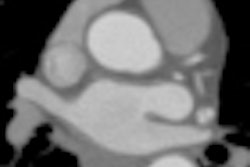SAN DIEGO - One-fifth of consecutive CT scans for all indications in a U.K. teaching hospital demonstrated a new malignancy, according to a study presented Monday at the American Thoracic Society (ATS) conference.
"Our findings suggest that we should reassess our opposition to CT screening in the U.K.," said Dr. Anindo Banergee, a senior registrar in medicine at St. Thomas' NHS Foundation Trust in London, who presented the findings.
Methods for early diagnosis of lung cancer such as CT screening are under intense scrutiny in both the U.S. and Europe, and trials are under way to validate its use, Banergee observed. In the U.S., the National Lung Screening Trial (NLST) has already enrolled almost 650,000 current or former smokers across 30 sites.
The situation in the U.K. is complicated by the fact that CT is known to have a poor sensitivity for central squamous cell carcinoma, the predominant pathology in the U.K. For this reason, there has been muted enthusiasm for CT screening in the UK, he said.
In the present study, the U.K. investigators conducted a retrospective audit of all adult CT scans performed at their institution over a seven-day period. Of 198 CT scans that were reviewed, 71% included full images of the lungs, and the remaining 29% were partial images.
According to the results, 18.1% of scans demonstrated a definite (14.6%) or possible malignancy (3.5%). Of those, 14% were an incidental finding and prompted further diagnostic investigations such as PET/CT scanning and/or biopsy, representing 2.5% of the total scans reviewed.
Based on the results, Banergee called for CT screening in high-risk smokers and patients with prior lung or head and neck cancers.
"A key feature of our study is that it illustrates one of the main stumbling blocks to acceptance of CT screening in the U.K.; i.e., what to do with those patients in whom an abnormality has been found on the CT," he said.
This is a particularly important question for those in whom the lesion on CT is small or atypical. Banergee emphasized that all of these patients need assessment by a respiratory specialist, who is preferably part of a multidisciplinary lung cancer team. Lung cancer is the leading cause of death due to malignant disease in the U.K., with more than 39,000 deaths per year.
By Jill Stein
AuntMinnie.com contributing writer
May 24, 2006
Related Reading
Part II: Automated CT lung nodule assessment advances, May 16, 2006
Part I: Automated CT lung nodule assessment advances, April 17, 2006
Low lung cancer detection rate seen in Dutch/Belgian study, March 3, 2006
CT screening identifies curable lung cancers, February 14, 2006
I-ELCAP data suggest need to work up secondary lung lesions, January 9, 2006
Copyright © 2006 AuntMinnie.com



















